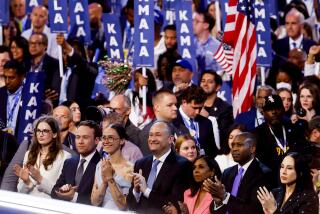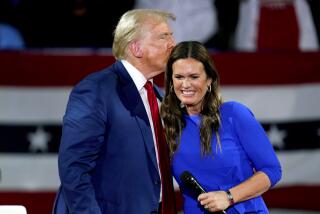Clinton’s Target Audience: Married, With Children
- Share via
WASHINGTON — School uniforms. Teen curfews. More educational programming on television for children.
At times it sounds as though Bill Clinton is running for president of the PTA, not president of the United States.
Clinton’s support for each of these ideas--and like-minded administration initiatives that he most recently touted Tuesday in his speech at Glendale Community College--are all part of a concentrated White House effort to address the anxieties of a voting bloc so large it is often overlooked: the nation’s 53 million married couples, particularly those with children.
Political commentators and strategists usually dwell more on the gender gap--the tendency of women to favor Democrats--than the political impact of marital status. But reliable support from married couples was a cornerstone of the GOP coalition that dominated presidential politics from 1968 through 1988.
Throughout that period, married voters--who make up about two-thirds of the electorate--favored Republicans so much more heavily than singles that some political analysts began to speak of a “marriage gap.” Indeed, the Democratic nominee for president has not carried a majority of married voters since 1964, according to post-election surveys by the University of Michigan’s Center for Political Studies. When Democrats have won, they have done so by narrowing the GOP edge among married Americans while gaining heavy support among singles.
Now, however, Clinton is closing that gap: Polls this year consistently show the president leading presumptive GOP nominee Bob Dole among married voters.
To some plotting Clinton’s reelection, that improved standing among married couples may be the single most important factor in Clinton’s political renaissance over the past year. Even the more highly touted gender gap is so wide this year largely because Clinton has added an unusually strong showing among married women to the Democrats’ traditional lead with single women.
“Clinton’s support is now pretty well distributed,” said one senior political advisor to the campaign, “but the key to it is married couples.”
Solidifying that majority among married couples has been a chief goal of White House policymakers, for despite Clinton’s current lead, the marriage gap hasn’t completely disappeared this year. And ranking Democrats privately acknowledge that Clinton’s hold on married voters is not as secure as his appeal to singles.
For that reason, many analysts believe married couples will become the pivot of the campaign. Strategists in both parties agree that Dole is unlikely to climb back into the race unless he can reestablish the traditional Republican advantage with married voters.
“If the White House can break even with married people, then they win the election, no problem,” says Martin P. Wattenberg, a political scientist at UC Irvine. “There is nothing Dole is offering that is going to win him the single vote.”
The gulf between married and single voters extends beyond the presidential vote. Married voters are much more likely than singles to describe themselves as conservative. On questions such as whether abortion should remain legal, whether sex before marriage is wrong, whether it is inappropriate for women to bear children out of wedlock, married voters--including married women--take more conservative positions than singles, polls show. Those views have made married voters--especially those in families with women at home taking care of children--more receptive to Republican appeals to “traditional” and “family” values.
On the flip side, singles tend to be more economically anxious than married voters, and thus more receptive to traditional Democratic calls for the government to enhance economic security.
“It is partly economic: Marrieds have greater economic security,” says Republican pollster Fred Steeper, who is advising the Dole campaign. “Partly the fact is that being married reflects some traditional values about life. You have both things going on.”
What other factors contribute to the marriage gap? A significant part of the answer is demographic. Women and minorities--both of whom lean Democratic--constitute a larger proportion of single than married voters; young voters, who have been warm toward Clinton, are also disproportionately represented among singles. Married voters are also somewhat more affluent than singles.
But these differences don’t explain the entire phenomenon. The marriage gap persists across race and gender. Among women, for example, George Bush ran much better among those who were married than among singles in both 1988 and 1992, according to the University of Michigan research. Even controlling for race and income, affluent white singles this year are much more likely to support Clinton than are their married counterparts.
The unsolved riddle is whether marriage itself makes people more conservative or whether people who choose to marry are more conservative to begin with, culturally and otherwise, than those who choose to be single.
Like others who have studied the issue, Bruce Blakeman, a Republican pollster, concludes the answer is “a combination of both.”
Those who marry tend to hold more traditional social views than singles: Married couples, for instance, are much more likely to attend church regularly than singles, polls by the Pew Research Center show. At the same time, the experiences associated with marriage--particularly buying a home and raising children--often reinforce the shift toward the right, Blakeman and others note.
Yet, so far this election year, Clinton has surmounted this trend to seize the lead among both single and married voters. In the most recent Los Angeles Times Poll, Clinton led Dole by 29 percentage points among singles and by 13 points among married couples. But compared with his showing in 1992, Clinton has gained more ground among married than single voters. At this point, Dole leads only among families with the most traditional structure, where one parent remains at home; two-earner married couples give Clinton a decisive advantage, according to the most recent Times Poll.
Throughout his national career, Clinton has targeted voters with families: His presidential announcement speech in October 1991 was memorable largely for addressing his fellow baby boomers not as aging protesters but as parents of young children.
But Clinton’s courtship of married voters has measurably intensified over the past several months.
In part, the shift reflects the influence of the team shaping Clinton’s reelection strategy. Clinton’s 1992 campaign strategists considered alienated working-class white voters the key swing bloc in the electorate. But Clinton’s new 1996 team--which includes strategist Dick Morris and pollsters Doug Schoen and Mark Penn--believes that more affluent suburban two-parent families are, in fact, the critical swing bloc who will decide the election.
Over the past year, Clinton has advanced with married voters along three separate tracks, White House political strategists believe. The first step, they argue, has been to neutralize traditional Republican advantages by moving rightward on polarizing ideological issues like welfare, crime and the balanced budget. The second step has been to blend into Clinton’s warnings about economic insecurity more optimistic notes about the opportunities in the emerging “Information Age.”
Along the third--and probably most important--track, Clinton has systematically promoted government programs intended to provide parents with tangible assistance in raising their children.
That emphasis binds a flock of recent White House proposals, from Clinton’s endorsement of school uniforms and teenage curfews, to his attacks on tobacco advertising aimed at children and support for the V-chip and a voluntary television rating system “so parents can control the shows their children watch,” as the president recently put it.
Legislation mandating family and medical leave; the expansion of student loans; and money to improve security at schools: All of these Clinton initiatives follow this path as well.
The White House promises more notes from this song sheet at a conference later this month on balancing work and family that Vice President Al Gore will chair in Nashville.
Clinton’s tax-cutting agenda revolves largely around parenting as well: His core proposals--a tax credit for middle-income families with young children, a new tax deduction and credit for college tuition costs--are all focused on the expenses of rearing children.
Similarly, Clinton also kept young parents in sight when formulating his strategy on the budget. Though his rejection of GOP proposals to reduce the rate of growth in Medicare and Medicaid brought the most immediate political gains with senior citizens, White House officials believe his positions also spoke to the concerns of middle-aged families coping with both young children and elderly parents.
“It is all about giving parents tools,” says George Stephanopoulos, a senior advisor to the president.
Republicans don’t cede the ground of providing parents tangible help. The cornerstone of the congressional Republican tax plan is a $500-per-child credit for families; Dole, like Clinton, backs teenage curfews; and inside the Dole campaign some officials are talking about a new initiative that would encourage companies to provide greater flex-time to workers.
But Dole has opposed other key elements in Clinton’s “parenting” agenda, including the laws requiring family leave and the installation of the V-chip in new televisions. And, in their efforts to recapture married voters, Republicans put much more hope on reopening the basic liberal-conservative ideological division that Clinton has worked so assiduously to close, particularly on taxes, spending, and social issues like welfare and gay marriage.
“A big part of this is showing that Clinton is not the conservative he is making himself out to be . . . especially on social issues,” says Steeper.
With Dole stressing ideology, and Clinton banking on “tools” for parents, much of the election could turn on the voters’ verdict about which one of these approaches more nearly defines family values in the mid-1990s.
Times poll researcher Monika McDermott contributed to this story.
More to Read
Get the L.A. Times Politics newsletter
Deeply reported insights into legislation, politics and policy from Sacramento, Washington and beyond. In your inbox twice per week.
You may occasionally receive promotional content from the Los Angeles Times.










